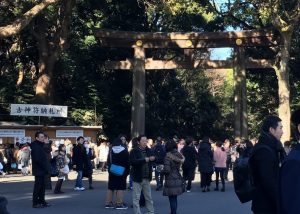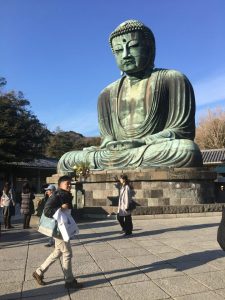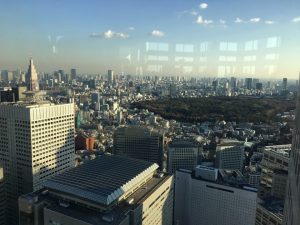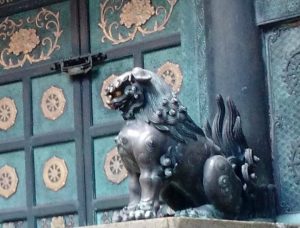On the day of January 6, 2018, our two classes went to the Meiji Shrine in Shibuya, Tokyo. We walked under this large arch and a pathway lead to the shrine. There were pamphlets to demonstrate how to properly wash ourselves at the cleansing stations. Since it is the start of the new year, extra cleansing stations sat next to the proper ones. The Shinto shrine is dedicated to the deified spirits of Emperor Meiji and his wife, Empress Shōken. Several women dressed in kimonos and booths lined the center of the shrine, selling lucky charms and other souvenirs. People lined up to pray to the gods and hang up their wishes for the new year.


During our free days on January 16, 2018, the group that I travelled with visited the Kōtoku-in, a Jōdo-shū Buddhist temple in Kamakura in Kanagawa Prefecture. It was a pathway that looked like a park to the shrine. It wasn’t quite as busy but many school children exited that we initially thought it was a school. There also was a cleansing area. It cost 200 yen while the Meiji Shrine was free to all patrons. We also were able to pay 20 yen to enter inside of the huge Buddha statue. Behind all of the temple buildings, there was a bathroom and a rock garden for meditation.


Towards the end of that day, we visited the Enoshima shrine on the island in Kanagawa. The Shinto shrine was split up into several levels with pay-to-use escalators available for those who needed it. A lot of families and couples attended. There’s a cafe with ice cream and a sitting area at the top where we watched the sunset. You could see Mt. Fuji, the bay, and city sprawled out around us. They also had a solar powered garden of lights. The view was enchanting.


One of the prompts that we are posed in this class is “Describe Japan’s natural landscape.” I have observed that from a large city like Tokyo to the Enoshima Island, they see value in respecting nature. It can be illustrated in the specific allocation of land for the Meiji shrine, seemingly carved out in the middle of Tokyo and the beautiful views of Mount Fuji from atop the hills in Enoshima.

One of the prompts that we are posed in this class is “Describe Japan’s natural landscape.” I have observed that from a large city like Tokyo to the Enoshima Island, they see value in respecting nature. It can be illustrated in the specific allocation of land for the Meiji shrine, seemingly carved out in the middle of Tokyo and the beautiful views of Mount Fuji from atop the hills in Enoshima. Despite the expansion of modern life evident in Japan, they have found ways to integrate the natural world in their everyday lives.
I personally found the way how each site funded their upkeep interesting as well as how even though they were religious monuments, I couldn’t help but feel that they catered to tourists and visitors. I acknowledge that that’s how they keep their temples and shrines in the best conditions, but I also feel that having a cafe at the top of a temple detracts away from the religious importance and commercializes the experience.
